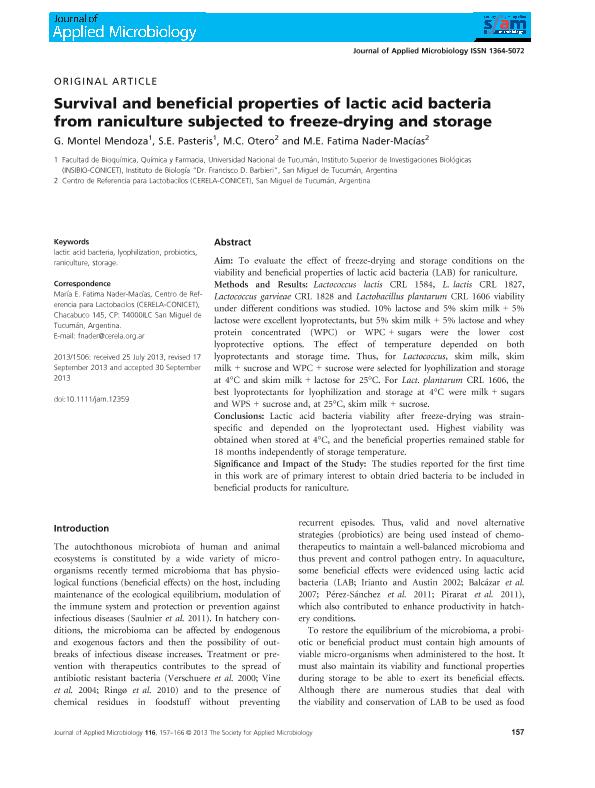Artículo
Survival and beneficial properties of lactic acid bacteria from raniculture subjected to freeze-drying and storage
Montel Mendoza, María Gabriela ; Pasteris, Sergio Enrique
; Pasteris, Sergio Enrique ; Otero, María Claudia
; Otero, María Claudia ; Nader, Maria Elena Fatima
; Nader, Maria Elena Fatima
 ; Pasteris, Sergio Enrique
; Pasteris, Sergio Enrique ; Otero, María Claudia
; Otero, María Claudia ; Nader, Maria Elena Fatima
; Nader, Maria Elena Fatima
Fecha de publicación:
01/2014
Editorial:
Wiley
Revista:
Journal of Applied Microbiology
ISSN:
1364-5072
e-ISSN:
1365-2672
Idioma:
Inglés
Tipo de recurso:
Artículo publicado
Clasificación temática:
Resumen
Aim: To evaluate the effect of freeze-drying and storage conditions on the viability and beneficial properties of lactic acid bacteria (LAB) for raniculture. Methods and Results: Lactococcus lactis CRL 1584, L. lactis CRL 1827, Lactococcus garvieae CRL 1828 and Lactobacillus plantarum CRL 1606 viability under different conditions was studied. 10% lactose and 5% skim milk + 5%lactose were excellent lyoprotectants, but 5% skim milk + 5% lactose and whey protein concentrated (WPC) or WPC + sugars were the lower cost lyoprotective options. The effect of temperature depended on both lyoprotectants and storage time. Thus, for Lactococcus, skim milk, skim milk + sucrose and WPC + sucrose were selected for lyophilization and storage at 4°C and skim milk + lactose for 25°C. For Lact. plantarum CRL 1606, the best lyoprotectants for lyophilization and storage at 4°C were milk + sugars and WPS + sucrose and, at 25°C, skim milk + sucrose. Conclusions: Lactic acid bacteria viability after freeze-drying was strain specific and depended on the lyoprotectant used. Highest viability was obtained when stored at 4°C, and the beneficial properties remained stable for 18 months independently of storage temperature. Significance and Impact of the Study: The studies reported for the first time in this work are of primary interest to obtain dried bacteria to be included in beneficial products for raniculture.
Palabras clave:
Lactic Acid Bacteria
,
Liophylization
,
Probiotics
,
Raniculture
,
Storage
Archivos asociados
Licencia
Identificadores
Colecciones
Articulos(CERELA)
Articulos de CENTRO DE REFERENCIA PARA LACTOBACILOS (I)
Articulos de CENTRO DE REFERENCIA PARA LACTOBACILOS (I)
Citación
Montel Mendoza, María Gabriela; Pasteris, Sergio Enrique; Otero, María Claudia; Nader, Maria Elena Fatima; Survival and beneficial properties of lactic acid bacteria from raniculture subjected to freeze-drying and storage; Wiley; Journal of Applied Microbiology; 116; 1; 1-2014; 157-166
Compartir
Altmétricas



